
From Light and Refreshing to Rich and Velvety: Discover the Two Facets of Japanese Green Tea
Why does one cup of Japanese green tea look crystal clear while another glows with a deep, almost opaque green? The secret lies in the steaming process: and it’s what sets Sencha apart from Fukamushicha. This subtle difference creates striking contrasts in flavour, aroma, and appearance, offering tea lovers two very different journeys in every sip.
Whether you prefer a light, refreshing cup or a rich, full-bodied brew, understanding Sencha vs Fukamushicha can help you make the perfect choice. Let's dive into it below!
Origins of Sencha
The story of Sencha begins in 1738 with Nagatani Soen, a tea master from Uji's Yuyandani region. He revolutionised Japanese tea by introducing the steaming method, an improvement on the older kamairi (pan-firing) and tencha techniques. In his process, freshly picked tea leaves were quickly steamed to preserve their vivid green colour, then carefully rolled and dried over a heated furnace lined with Japanese paper. This innovation marked the birth of modern sencha, the tea that would go on to become Japan's most beloved brew.
Origins of Fukamushicha

Fukamushicha, or deep-steamed tea, traces its roots to the Makinohara Plateau in Shizuoka Prefecture. Surprisingly, this region, now Japan's largest tea-producing area, was once barren land.
After the fall of the Edo Shogunate in 1868, many former samurai lost their livelihoods. In 1869, about 200 members of Tokugawa Yoshinibu's guard, led by Nakajo Kageaki, began cultivating the Makinohara Plateau as a way to support themselves. The work was grueling: the soil was poor, capital was scarce, and many gave up. But with the help of local farmers and labourers, cultivation slowly continued, and by early Meiji era, tea plantations stretched across 500 hectares.
Over time, Makinohara became home to vast tea fields. Yet, the tea produced there was initially unpopular: the thicker leaves gave a stronger astringency than mountain-grown teas. In the 1950s, Shizuoka farmers discovered that by steaming the leaves longer, for about 60 to 80 seconds, they could mellow the bitterness and create a richer, smoother brew. This innovation gave birth to Fukamushicha, now cherished for its deep flavour and vibrant green cup.
Nutrients in Sencha vs Fukamushicha

Both Sencha and Fukamushicha are packed with beneficial compounds such as catechins, caffeine, amino acids, vitamins, and minerals. Interestingly, about 70 - 80% of these nutrients remain locked in the leaves rather than being dissolved in hot water.
Because the leaves in Fukamushicha are broken down more finely during the deep-steaming process, more of these insoluble nutrients such as dietary fibre, beta-carotene, vitamin E, and trace minerals such as copper, zinc, and manganese, make it into your cup. This also explains Fukamushicha's vibrant deep green colour, created by fine leaf particles suspended in the tea. To enjoy its full benefits, gently swirl your cup to mix in the settled leaves before drinking or brew the tea in a teapot with strainer to get rid of sediment.
Whether you prefer the crisp elegance of Sencha or the smooth depth of Fukamushicha, exploring both is a journey into the heart of Japan's tea culture. So, the next time you brew a cup, let your tastebuds and heart guide you, there is no wrong choice -- only a new discovery waiting in every sip.
Ready to discover your favorite cup? Browse our collection of authentic Sencha and Fukamushicha, and bring the flavours of Japan straight to your teapot.




1 comment
Great read! I never knew about Fukamushicha
Belle
Leave a comment
This site is protected by hCaptcha and the hCaptcha Privacy Policy and Terms of Service apply.